Coosa River
| Coosa River | |
 Fall colors on the Coosa River near Wetumpka, Alabama | |
| Country | United States |
|---|---|
| State | Alabama |
| Source | junction of Oostanaula River and Etowah River |
| - location | at Rome, Georgia |
| - elevation | 575 ft (175 m) [1] |
| - coordinates | 35°15′14″N 85°10′39″W / 35.25389°N 85.17750°W [2] |
| Mouth | Alabama River |
| - location | near Montgomery, Alabama |
| - elevation | 121 ft (37 m) [2] |
| - coordinates | 32°29′10″N 86°16′40″W / 32.48611°N 86.27778°WCoordinates: 32°29′10″N 86°16′40″W / 32.48611°N 86.27778°W [2] |
| Length | 280 mi (451 km) [1] |
| Basin | 10,100 sq mi (26,159 km2) [3] |
| Discharge | for USGS gage 02411000, Coosa River at Jordan Dam near Wetumpka, AL |
| - average | 15,950 cu ft/s (452 m3/s) [4] |
| - max | 256,000 cu ft/s (7,249 m3/s) |
| - min | 54 cu ft/s (2 m3/s) |
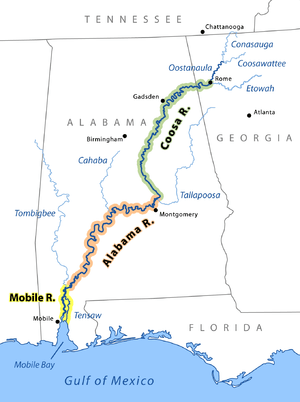 The Coosa River is the major tributary when it joins the Tallapoosa River near Wetumpka, Alabama to form the Alabama River.
| |
The Coosa River is a tributary of the Alabama River in the U.S. states of Alabama and Georgia. The river is about 280 miles (450 km) long.[1]
The Coosa River begins at the confluence of the Oostanaula and Etowah rivers in Rome, Georgia, and ends just northeast of the Alabama state capital, Montgomery, where it joins the Tallapoosa River to form the Alabama River just south of Wetumpka. Around 90% of the Coosa River's length is located in Alabama. Coosa County, Alabama, is located on the Coosa River.
The Coosa is one of Alabama's most developed rivers. Most of the river has been impounded, with Alabama Power, a unit of the Southern Company, maintaining seven dams on the Coosa River. The dams produce hydroelectric power , but are costly to some species endemic to the Coosa River.
History
Native Americans had been living on the Coosa Valley for millennia before Hernando de Soto and his men became the first Europeans to visit it in 1540. The Coosa chiefdom was one of the most powerful chiefdoms in the southeast at the time.
Over a century after the Spanish left the Coosa Valley, the British established strong trading ties with the Creek bands of the area around the late 17th century, much to the dismay of France. With a base in Mobile, Alabama, the French believed that the Coosa River was a key gateway to the entire South and they wanted to control the valley. The main transportation of the day was by boat. The convergence of the Coosa and Tallapoosa rivers near present-day Montgomery forms the Alabama River, which has its mouth at Mobile Bay, the port used by the French for travel around the Caribbean and to France. They wanted to retain control of both the Coosa and the Alabama rivers.
In the early 18th century, almost all European and Indian trade in the southeast ceased during the tribal uprisings brought on by the Yamasee War against the Carolinas. After a few years, the Indian trade system was resumed under somewhat reformed policies. The conflict between the French and English over the Coosa Valley, and much of the southeast in general, continued. It was not after Britain had defeated France in the Seven Years' War (also known as the French and Indian War that France relinquished its holdings east of the Mississippi River to Britain. This was stated in the Treaty of Paris signed by both nations in 1763.
By the end of the American Revolutionary War, the Coosa Valley was occupied in its lower portion by the Creek and in the upper portion by the Cherokee peoples, who had a settlement near its start in northwest Georgia. After the Fort Mims massacre near Mobile, General Andrew Jackson led American troops, along with Cherokee allies, against the Lower Creek in the Creek War. This culminated in the Creek defeat at the Battle of Horseshoe Bend. Afterward, the Treaty of Fort Jackson in 1814 forced the Creek to cede a large amount of land to the United States, but left them a reserve between the Coosa and Tallapoosa rivers in northern Alabama. Even there the Creeks were encroached on by European-American settlers who had begun moving into their territory from the United States.
Finally, during the 1820s and 1830s the Creek, Cherokee, and virtually all the southeastern Indians were removed to Indian Territory (present-day Oklahoma). The Cherokee removal is remembered as the Trail of Tears. The Cherokee capital city of New Echota was located on the headwater tributaries of the Coosa River, in Georgia, until the tribe's removal. The Creek and Choctaw removals were similar to the Cherokee Trail of Tears. After the removals, the Coosa River valley and the southeast in general was wide open for American settlers. The cotton gin made short-staple cotton profitable to process, and it was a new cotton hybrid that could be grown in the upland regions; large-scale migrations known as "Alabama Fever" filled Alabama with new settlers.
The first river town to form in the Coosa Basin was at the foot of the last waterfall on the Coosa River, the "Devil's Staircase." Settlers soon adopted the native name Wetumpka (meaning "rumbling waters" or "falling stream") for this new community.
The Coosa River was an important transportation route into the early 20th century as a commercial waterway for riverboats along the upper section of the river for 200 miles south of Rome. However, shoals and waterfalls such the Devil's Staircase along the river's lowest 65 miles blocked the upper Coosa's riverboats from access to the Alabama River and the Gulf of Mexico.
The building of the dams on the Coosa - Lay, Mitchell and Jordan — allowed Alabama Power to pioneer new methods of controlling and eliminating malaria, which was a major health issue in rural Alabama in the early 1900s. So successful were their pioneering efforts in this area, that the Medical Division of the League of Nations visited Alabama to study the new methods during the construction of Mitchell Dam.[5]
For a time, the Popeye the Sailorman cartoons were inspired by Tom Sims, a Coosa River resident in Rome, Georgia who was familiar with riverboat life and characters of the early 1900s .[6]
Impoundments and sections
The following table describes the seven impoundments on the Coosa River from the south to north built by the Alabama Power Company as well as the tailwater section below Jordan Dam. Harvey H. Jackson III in a book Putting Loafing Streams To Work characterized the importance of the first Coosa River dams as follows:
| “ |
Prior to 1912 only seventy-two Alabama communities had electricity, but by 1928, when Jordan Dam went into operation, Alabama Power served four hundred twenty-one communities in sixty-one of Alabama's sixty-seven counties. The company also provided power for coal and iron mines, cotton mills, cement plants, quarries, steel plants and rolling mills, foundries, pipe plants and machine shops, ice plants, public utilities, and electric furnance installations, industries that put thousands of [Alabama] citizens to work.[7] |
” |
| Impoundment/Section | Description | Images |
|---|---|---|
| Jordan Dam Tailwater | The Jordan Dam Tailwater flows approximate 7.5 miles into Wetumpka, Alabama and is a combination of pools, shoals and rapids. Alabama Power currently maintains minimum flow releases from Jordan Dam for whitewater boating and aquatic enhancement of the Coosa and Alabama Rivers below the dam. This section of river is home to the infamous Moccasin Gap rapids, a class III whitewater. | 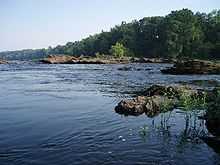 Pipeline Falls section of Coosa River, near Wetumpka, Alabama |
| Lake Jordan | Lake Jordan was impounded December 31, 1928 and named after the maiden name (Jordan) of the mother of Reuben and Sidney Mitchell, who were instrumental in the construction of Mitchell Dam on the Coosa River. The dam is 125 ft high and impounds 6800 acres (28 km²). Lake Jordan has a surface elevation of 252’ MSL and 180 miles of shoreline. The nearest town is Wetumpka, Alabama. It is an Alabama Power lake with an 100,000 Kilowatt generating capacity. Lake Jordan is an excellent recreational lake with fishing opportunities for largemouth bass, spotted bass, bluegill and other sunfish, crappie, catfish, striped bass, hybrid and white bass. It was the location of the 2004 Bass Masters Classic Tournament. The lake has two public access sites maintained by Alabama Power.[8] |  Sunset Over Lake Jordan Near Weoka Creek, 1996. |
| Lake Bouldin | Impounded July 27, 1967 and named for Walter Bouldin, Bouldin is part of Lake Jordan and is connected to Lake Jordan and the Coosa River by two man made canals. Bouldin added 225,000 kilowatt generating power to the Lake Jordan system. On February 10, 1975, an earth embankment section of Walter Bouldin Dam breached, causing total evacuation of the forebay reservoir and rendering the 225-MW power plant inoperable.[9][10] No casualties or property damage (beyond the dam itself) were reported, and the dam was subsequently reconstructed. | |
| Lake Mitchell | Lake Mitchell was impounded August 15, 1923 and named for James Mitchell, Alabama Power president from 1912 to 1920. The dam impounds 5850 acres (24 km²) and created a lake with 147 miles of shoreline. The nearest town is Clanton, Alabama. Lake Mitchell is an Alabama Power lake with an 170,000 kilowatt generating capacity. It is an excellent recreational lake with fishing opportunities for largemouth bass, spotted bass, bluegill and other sunfish, crappie, catfish, walleye, striped bass, hybrid and white bass. Alabama Power maintains three public access sites on the lake.[11] | 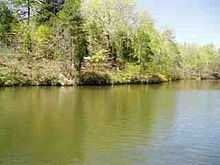 Typical Spring Time Shoreline On Lake Mitchell, Coosa River, 2006 |
| Lay Lake | Lay Lake was impounded in 1914 and named after Captain William Patrick Lay, the first Alabama Power President. The dam impounds 12,000 acres (49 km²) with a shoreline of 289 miles. The nearest town is Columbiana, Alabama. Lay Lake is an Alabama Power lake with 177,000 kilowatt generating capacity. It is an excellent recreational lake with fishing opportunities for largemouth bass, spotted bass, bluegill and other sunfish, crappie, catfish, striped bass, hybrid and white bass. Alabama Power maintains seven public access sites on the lake. Lay Dam was one of the earliest concrete dams in the US and its construction helped pioneer dam building technology in the early 20th century.[12] |  Lay Dam From Eastern Shoreline of Coosa River, 1996. |
| Lake Logan Martin | Lake Logan Martin was impounded August 10, 1964 and named after William Logan Martin, Jr. He was a circuit court judge in Montgomery and also served as attorney general for the State of Alabama. The lake covers 15,263 acres (61.8 km²) and has 275 miles of shoreline. The nearest town is Pell City, Alabama. Lake Logan Martin is an Alabama Power lake with an 128,250 Kilowatt annual generating capacity. It is an excellent recreational lake with fishing opportunities for largemouth bass, spotted bass, bluegill and other sunfish, crappie, catfish, striped bass, hybrid and white bass. Alabama Power maintains three public access sites on the lake.[13] | 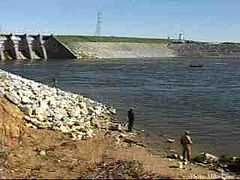 Tailwater Fishery below Logan Martin Dam on the Coosa River, 1996. |
| Lake Neely Henry | Lake Neely Henry was impounded June 2, 1966 and named for H. Neely Henry, a senior executive vice-president of Alabama Power Company. The dam impounds 11,200 acres (45.3 km²) with 339 miles of shoreline. The nearest town is Ohatchee, Alabama. Lake Neely Henry is an Alabama Power lake with an 72,900 kilowatt generating capacity. It is an excellent recreational lake with fishing opportunities for largemouth bass, spotted bass, bluegill and other sunfish, crappie, catfish, striped bass, hybrid and white bass. Alabama Power maintains three public access sites on the lake.[14] | 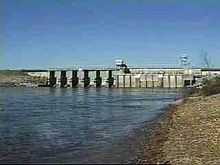 Neely Henry Dam and Powerhouse, Coosa River near Anniston, Alabama, 1996. |
| Lake Weiss | Lake Weiss was impounded June 5, 1961 and named for F.C. Weiss, a former chief engineer of Alabama Power. The dam impounds a 30,200 acres (122 km²) lake with 447 miles of shoreline. The nearest town is Leesburg, Alabama. Lake Weiss is an Alabama Power lake with an 87,750 kilowatt generating capacity. It is an excellent recreational lake with fishing opportunities for largemouth bass, spotted bass, bluegill and other sunfish, crappie, catfish, striped bass, hybrid and white bass. Weiss Lake is known for it excellent crappie fishing and often called the “Crappie Capital of the World”. Alabama Power maintains five Public Access sites on the lake.[15] | 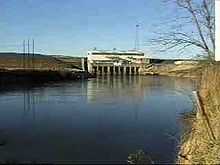 Weiss Dam and Power Plant on Coosa River, 1996. |
Flora and fauna biodiversity highlights
In the Middle Coosa River Watershed, 281 occurrences of rare plant and animal species and natural communities have been documented, including 73 occurrences of 23 species that are federal or state protected. Ten conservation targets were chosen: the riverine system, matrix forest communities (oak hickory-pine forest), gray bat (Myotis grisescens), riparian vegetation, mountain longleaf pine (Pinus palustris) forest communities, red-cockaded woodpecker (Picoides borealis), critically imperiled aquatic species (fish, mussels, and snails), southern hognose snake (Heterodon simus), caddisflies, and imperiled plants. Maintaining the biodiversity of the Coosa River system is particularly important because it has already lost a significant portion of its aquatic fauna to extinction.[16]
| Category | Summary | Details
(S)=State Status (F)=Federal Status |
|---|---|---|
| Aquatic gastropods (snails) |  shell and operculum of extinct Clappia umbilicata
|
Endangered, threatened, and rare species
|
| Amphibians | 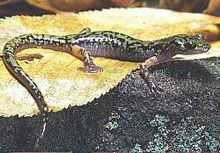 Green salamander |
Endangered, threatened, and rare species
|
| Fish | 87 species representing 17 families (13 of the fish species have been listed for protection by federal or state agencies as endangered, threatened, or rare.)
 Lake sturgeon The lake sturgeon (Acipenser fulvescens), a threatened species and once prevalent in the Coosa River system until the 1960s, is being re-introduced by the Georgia Department of Natural Resources.[18] The Alabama sturgeon, a former resident of the Coosa River below the fall line was placed on the endangered species list in September 2000[19] |
Endangered, threatened, rare and invasive species
|
| Mussels | Freshwater mussels serve as natural filtration systems that help keep the water clean and clear. Georgia has 98 species of mussels laying its claim to the most diverse mussel fauna of the 50 states. Eleven species of these mussels native to the Coosa basin are currently listed or proposed for listing as endangered or threatened. 13 species are now extinct. Alabama has one of the richest and most diverse assemblages of mussels in the world with about 180 species. Approximately two-thirds of North American mussel species have been reported from Alabama.[20] | Endangered, threatened, and rare species |
| Plants |  Green pitcherplant The upper Coosa watershed in northeastern Alabama and north Georgia is home to the majority of the remaining clumps of the endangered green pitcherplant.[21] |
Endangered, threatened, and rare species
|
| Reptiles | The southern hognose snake was a candidate species (C2) for listing as either threatened or endangered by the U.S. Fish and Wildlife Service (USFWS). However, the USFWS discontinued the designation of C2 species as candidates for listing (50 CFR 17; 28 February 1996). The southern hognose snake is considered to be a species of concern, but more biological research and field study are needed to resolve its conservation
status.[22] |
Endangered, threatened, and rare species
|
| Birds and mammals |  Bald eagle The bald eagle, once an endangered species now has nesting populations on and in the vicinity of Coosa River impoundments[23] The largest concentration of clusters in Alabama of the red-cockaded woodpecker, an endangered species, occurs on lands adjacent to Lake Mitchell under the stewardship of Alabama Power.[23] |
Endangered, threatened, and rare species
|
Tributaries
The Coosa River's drainage has hundreds of tributaries, which have been divided into sections based on the different areas of the watershed. The first four sections are tributary systems that converge to form the main artery of the Coosa River in Georgia. These main tributary rivers are the Conasauga and Coosawattee Rivers, which together then form the Oostanaula River. The Oostanaula then joins with the Etowah River in Rome, Georgia, forming the Coosa River.
Other significant tributaries of the Coosa are:
- Amicalola Creek
- Armuchee Creek
- Big Wills Creek
- Cartecay River
- Cedar Creek
- Chattooga River
- Chocolocco Creek
- Coahulla River
- Ellijay River
- Hatchett Creek
- Heath Creek
- Little River
- Mill Creek
- Mountain Creek
- Raccoon Creek
- Rock Creek
- Spring Creek
- Sugar Creek
- Terrapin Creek
- Weogufka Creek (through Hatchett Creek)
| Location | Tributaries |
|---|---|
| Rome, GA to Weiss Dam[24] | Cedar Creek, Chattooga River, Spring Creek, Cowan River, Little River, Yellow Creek |
| Weiss Dam to H. Neely Henry Dam[24] | Ballplay Creek, Cove Creek, Henley Creek, Canoe Creek, Permita Creek, Green's Creek, Beaver Creek, Ottery Creek, Shoal Creek |
| H. Neely Henry Dam to Logan Martin Dam | Cheaha Creek |
| Logan Martin Dam to Lay Dam[24] | Kelly Creek, Talladega Creek, Tallaseehatchee Creek, Dry Branch, Bulley Creek, Beeswax Creek, Flat Branch, Cedar Creek, Sulphur Creek, Peckerwood Creek, Spring Creek, Blue Springs Creek, Reid Creek, Coaggie Creek, Waxahatchee Creek, Paint Creek |
| Lay Dam to Mitchell Dam[24] | Clay Creek, Walnut Creek, Hatchet Creek, Pennymotley Creek, Weougufka Creek, Cargile Creek, Blue Creek |
| Mitchell Dam to Jordan Dam[24] | Chesnut Creek, Shoals Creek, Weoka Creek, Sofkahatchee Creek |
| Jordan Dam to Confluence of Tallapoosa River[25] | Corn Creek |
Major cities
A number of significant cities lie on the banks of the Coosa River. They include:
- Gadsden, Alabama - between Weiss and H. Neely Henry lakes
- Rainbow City, Alabama - on the Coosa due south of Gadsden
- Childersburg, Alabama - near Lay Lake
- Rome, Georgia - headwaters
- Southside, Alabama - on the Coosa due south of Rainbow City
- Wetumpka, Alabama - near confluence with Tallapoosa River forming the Alabama River
Advocates
The Coosa-Alabama River Improvement Association, founded in 1890 in Gadsden, Alabama to promote navigation on the Coosa River is a leading advocate of the economic, recreational and environmental benefits of the Coosa River system.[26]
The Alabama Rivers Alliance works to unite the citizens of Alabama to protect peoples right to clean, healthy, waters.[27]
Alabama Water Watch is dedicated to volunteer citizen monitoring of water quality in Alabama Rivers.[28]
The Alabama Power Foundation is a non-profit foundation providing grants for watershed, environmental and community projects along the Coosa River and within the state of Alabama[29]
The Coosa River Basin Initiative is a grassroots environmental organization with the mission of informing and empowering citizens so that they may become involved in the process of creating a clean, healthy and economically viable Coosa River Basin.[30]
Coosa Riverkeeper is a citizen-based river conservation group that patrols the river, educates the public and advocates on behalf of the river. The staffed organization is based on Yellowleaf Creek and works in the Middle and Lower Coosa Basins.[31]
See also
- List of rivers of Georgia (U.S. state)
- List of rivers of Alabama
- List of dams and reservoirs in Alabama
References
- Atkins, Leah Rawl (2006). "Developed for the Service of Alabama" - The Centennial History of the Alabama Power Company 1906-2006. Birmingham, Alabama: Alabama Power Company. ISBN 978-0-9786753-0-1.
- Jackson, Harvey H. III (1997). Putting Loafing Streams To Work-The Building of Lay, Mitchell, Martin, and Jordan Dams, 1910-1929. Tuscaloosa, Alabama: The University of Alabama Press. ISBN 0-8173-0879-2.
- Jackson, Harvey H. III (1995). Rivers of History - Life on the Coosa, Tallapoosa, Cahaba and Alabama. Tuscaloosa, Alabama: The University of Alabama Press. ISBN 0-8173-0771-0.
- Kimbrow, Dustin R. (2013). Erosion Monitoring Along the Coosa River below Logan Martin Dam Near Vincent, Alabama, Using Terrestrial Light Detection And Ranging (T-Lidar) Technology. Reston, Virginia: U.S. Geological Survey.
Notes
- ↑ 1.0 1.1 1.2 U.S. Geological Survey. National Hydrography Dataset high-resolution flowline data. The National Map, accessed April 27, 2011
- ↑ 2.0 2.1 2.2 U.S. Geological Survey Geographic Names Information System: Coosa River
- ↑ "Water resources data for the United States, Water Year 2009; gage 02411600, Coosa River at Wetumpka, AL". USGS. Retrieved 4 August 2010.
- ↑ "Water resources data for the United States, Water Year 2009; gage 02411000, Coosa River at Jordan Dam near Wetumpka, AL". USGS. Retrieved 4 August 2010.
- ↑ Jackson, Harvey H. III, Putting Loafing Streams To Work, Tuscaloosa, Alabama: University of Alabama Press, pp. 113, 145-46, 1997.
- ↑ Popeye "The Sailor Man", Rome, Georgia Website
- ↑ Jackson, Harvey H. Jackson III, Putting Loafing Streams To Work, University of Alabama Press, Tuscaloosa, Alabama, page 187, 1997.
- ↑ Alabama Power Website, Facts About Dams
- ↑ Alabama Power Website, Facts About Dams
- ↑ Department of Energy, Energy Citations Database
- ↑ Alabama Power Website, Facts About Dams
- ↑ Alabama Power Website, Facts About Dams
- ↑ Alabama Power Website, Facts About Dams
- ↑ Alabama Power Website, Facts About Dams
- ↑ Alabama Power Website, Facts About Dams
- ↑ Alabama Non-Point Source Newsletter, Spring 2004
- ↑ Mobile River Basin Coalition
- ↑ Reintroduction of Lake Sturgeon
- ↑ Nature Reserve - Alabama Sturgeon
- ↑ Freshwater Mussels In Alabama
- ↑ NatureServe Data on Green Pitcherplant
- ↑ Jordan, Robert A.,Species Profile: Southern Hognose Snake (Heterodon simus) on Military Installations in the Southeastern United States, Technical Report SERDP-98-4, US Army Corps of Engineers, March 1998
- ↑ 23.0 23.1 Joint Alabama Power-US Fish and Wildlife Service Coosa Biological Assessment (July 2005).
- ↑ 24.0 24.1 24.2 24.3 24.4 Alabama Power Weiss Lake Recreation Map on the Coosa River, 1999
- ↑ General Highway Map, Elmore County Alabama, State of Alabama Highway Department, 1985
- ↑ Coosa-Alabama River Improvement Association Website, History
- ↑ Alabama Rivers Alliance Website
- ↑ Alabama Water Watch Website
- ↑ Alabama Power Foundation Website
- ↑ Coosa River Basin Initiative website
- ↑ Coosa Riverkeeper website
| Wikimedia Commons has media related to Coosa River. |